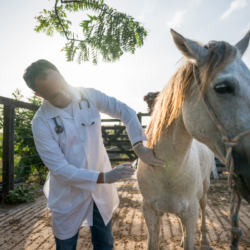Equine piroplasmosis is a severe parasitic disease that affects horses and can have serious consequences for their health. Caused by parasites transmitted by ticks, this disease, although not contagious, represents a real challenge for breeders and horse owners.
What causes this disease?
Equine piroplasmosis is caused by two main parasites, Theileria equi (T. equi) and Babesia caballi (B. caballi), commonly known as piroplasmas. These parasites invade horses’ red blood cells, causing them to burst. They are transmitted mainly through the bites of infected ticks, notably Dermacentor reticulatus, Dermacentor marginatus, Rhipicephalus bursa and Hyalomma marginatum. In France, these ticks feed on horses’ blood at every stage of their lives and can transmit the parasites through their saliva.
The disease is endemic in many regions, particularly in the southern two-thirds of France, where the climate and vegetation favour tick activity. Horses can remain carriers of piroplasmas for long periods, even after treatment. Ticks can also become infected on their first meal on a carrier host and remain infected for the rest of their lives, living for up to four years. In addition, iatrogenic transmission (via contaminated medical equipment) and vertical transmission (from the mare to her foetus) are possible, although less frequent.
What are the symptoms of equine piroplasmosis?
The symptoms of equine piroplasmosis vary according to the form of the disease: acute, sub-acute or chronic. After an incubation period of 10 days to 3 weeks, affected horses may present a variety of clinical signs.
Acute form
The acute form is characterised by a fever often in excess of 40°C, anorexia, fatigue and an increase in heart rate and respiratory rate. Mucous membranes may be pale, yellowish or congested with petechiae. Urine becomes dark. This is the most common form and requires prompt treatment to avoid serious complications.
Subacute form
The subacute form presents with intermittent fever, weight loss and sometimes signs of mild colic. Although less severe than the acute form, this form can nevertheless weaken the horse considerably and requires veterinary attention to prevent the animal’s condition worsening.
Chronic form
The chronic form is characterised by a drop in appetite, loss of body condition and reduced performance. There is also mild anaemia and intermittent spikes in hyperthermia. This form is often more difficult to diagnose because of its less specific symptoms. It is particularly common in donkeys.
Specific symptoms depending on the infectious agent
Specific symptoms vary according to the infectious agent. Babesia caballi causes severe hyperthermia, loss of appetite, anaemia, oedema of the limbs, and sometimes renal and cardiac complications. In some cases, colic and nervous symptoms may appear.
Theileria equi, on the other hand, causes fever, anaemia, severe jaundice and a slower but potentially fatal course within 24-48 hours. Latent forms are more common with Theileria equi, where the parasites can reappear when the immune defences fail.
Latent and acute forms
Latent forms are characterised by the presence of parasites in small quantities in the general bloodstream. They are often found in haematopoietic organs such as the liver, spleen and bone marrow. In the event of a drop in immune defences, the parasite may reappear in the general bloodstream.
The acute form, which is rarer and often seen in foals, is potentially fatal. It can cause severe anaemia, pronounced jaundice, extreme weakness and petechiae on the mucous membranes.
How is it diagnosed?
Diagnosis of equine piroplasmosis is based on several complementary methods. Following clinical suspicion, the vet may carry out a blood count to look for anaemia, although this is not specific to the disease.
Testing for piroplasm DNA using PCR (Polymerase Chain Reaction) is a highly sensitive technique. Laboratories or rapid tests carry out this analysis. Serology also tests for antibodies to Babesia caballi and Theileria equi. Techniques include ELISA, indirect immuno-fluorescence assay (IFAT) and complement fixation test (RFC). These tests are useful for diagnosing chronic and acute forms of the disease, and detecting asymptomatic chronic carriers.
A single positive serological test does not necessarily mean current infection, but indicates that the body has already encountered piroplasma. In the event of a fever of unknown origin, a declaration to RESPE (Réseau d’Épidémio-Surveillance en Pathologie Equine) is recommended. This will cover part of the cost of analyses and help to improve knowledge of the disease.
What treatments are available?
Equine piroplasmosis is treated mainly with imidocarb, currently the only antiparasitic molecule available in France. Treatment involves a series of two to three intramuscular injections, spaced 24 to 48 hours apart, depending on the type of parasite.
Imidocarb is effective against Babesia caballi but less so against Theileria equi, which can lead to relapses. Symptomatic treatment, including anti-inflammatories, may be administered to combat hyperthermia and other symptoms. Post-treatment monitoring is essential, as relapses may occur during periods of stress or fatigue.
In cases of severe anaemia, products to stimulate the production of red blood cells may be used. Donkeys are particularly sensitive to imidocarb and require appropriate doses. Sometimes, a blood transfusion is necessary.
Oxytetracycline, a broad-spectrum antibiotic, can also be used, especially for Theileria equi. This treatment requires daily intravenous injections for five days, but does not completely eliminate the parasite. The horse must be rested during treatment and supplemented with vitamins and minerals.
What are the natural alternatives?
To support the treatment of equine piroplasmosis, several natural alternatives strengthen the immune system and promote detoxification.Artichoke and desmodium have beneficial effects on the liver. Rosemary and milk thistle also help to detoxify the liver. Similarly, fumitory and black radish regulate biliary and hepatic functions.
Blackcurrant and birch facilitate the elimination of heavy acids and nitrogen waste respectively.Ash and pilosella eliminate kidney waste and prevent water retention.Nettle, rich in minerals and vitamins, improves the condition of anaemic horses. Spirulina, rich in vitamins and trace elements, increases energy potential.
What are the means of prevention?
Prevention of equine piroplasmosis is mainly based on reducing the risk of tick bites. It is essential to maintain pastures by eliminating areas where ticks can hide, such as clumps of leaves and scrub, and to clear the edges of undergrowth. Limiting access to wooded areas is also recommended.
Regular observation of horses, particularly when returning from rides and when being groomed, means that ticks can be removed quickly with a tick remover and the bitten area disinfected. The use of suitable acaricide and insecticide products, in consultation with a vet, can also help prevent tick bites.
Regular cleaning of the horses’ living areas is crucial. Hedges should be trimmed and meadows cleared to reduce the proliferation of ticks. Directly protecting horses by removing ticks as soon as they are visible and using suitable repellents is an important additional measure.
Although there is no vaccine, these precautionary measures, applied throughout the year, can significantly reduce the risk of piroplasmosis in horses.





